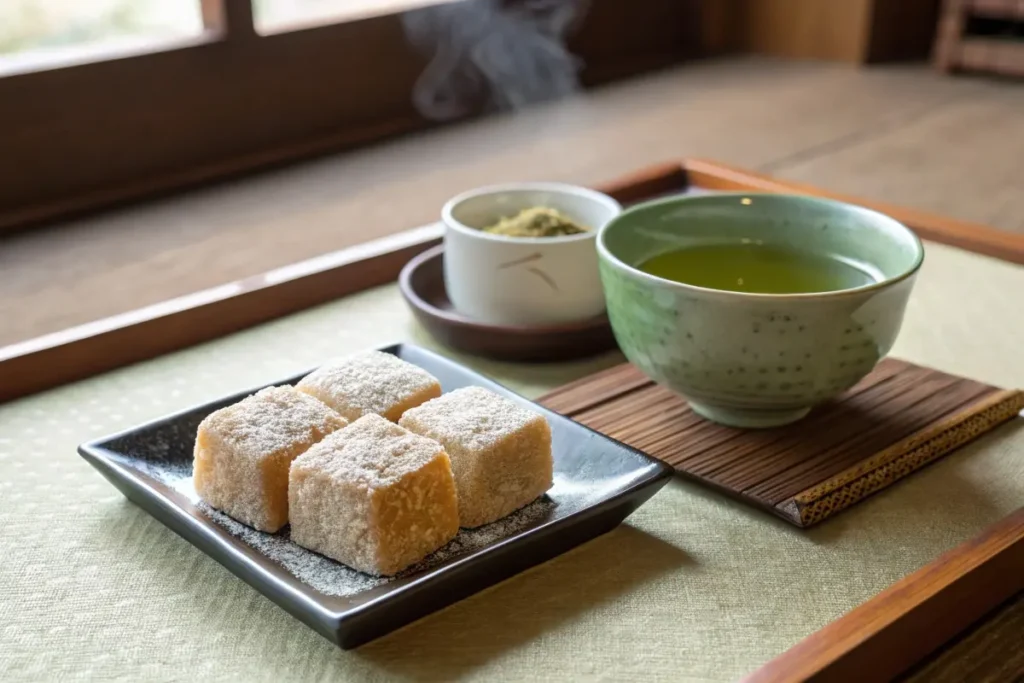Japanese cuisine is famous for its delicate sweets, each crafted with a respect for seasonality and refined taste. Among these confections, warabimochi stands out for its translucent appearance, subtle flavors, and a refreshingly light texture. Within the first bite, you’ll discover a delightful contrast between its tender, jelly-like consistency and the sweet, nutty coating of kinako (roasted soybean flour). Whether you’re an avid lover of mochi desserts or a culinary explorer in search of new treats, warabimochi offers an authentic taste of Japan’s traditional dessert culture.
Unlike classic mochi that’s made from glutinous rice flour, warabimochi is often crafted from bracken starch, giving it a distinctive look and mouthfeel. This dessert is typically served chilled, especially in the warmer months, bringing a cool, refreshing note to finish any meal. As you delve into this article, you’ll learn what is warabi mochi, its history, various recipes, and why it’s cherished all over Japan. So, prepare to immerse yourself in the world of warabimochi, from its age-old origins to modern interpretations that continue to captivate dessert enthusiasts everywhere.
Explore other iconic Japanese sweets for a deeper understanding of Japan’s vibrant dessert landscape.
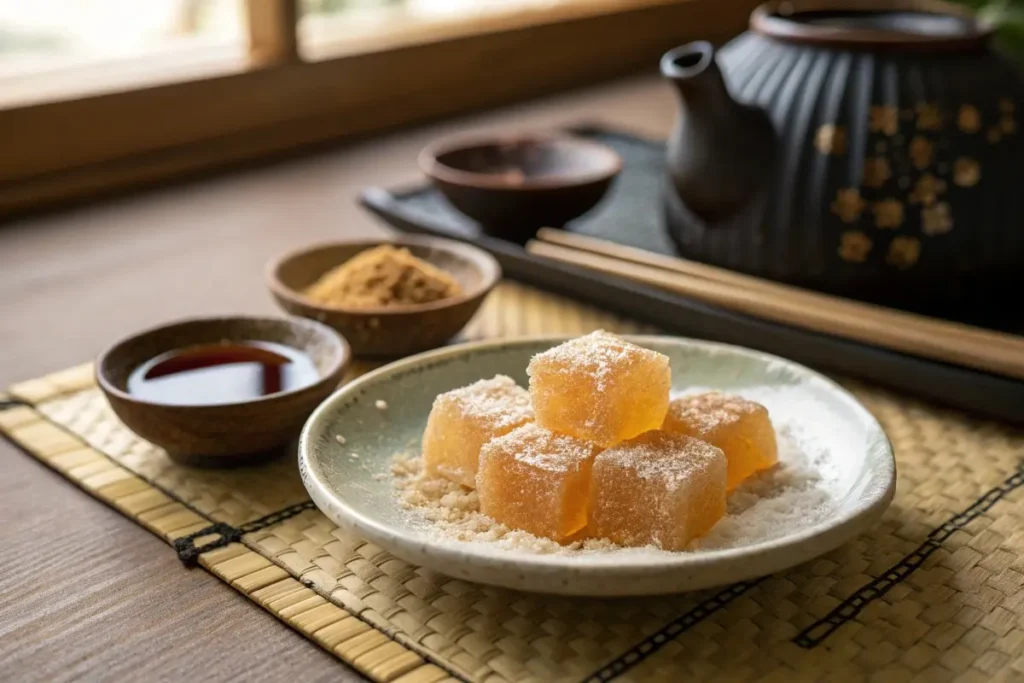
Table of Contents
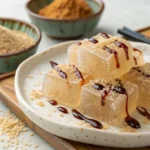
Warabimochi: A Delicious Journey into Japan’s Refreshing Dessert
- Total Time: 25
- Yield: 4 servings 1x
Description
Warabimochi – a cooling, jelly‑like Japanese dessert made from bracken starch, coated in roasted soybean flour (kinako) and often drizzled with kuromitsu (black sugar syrup); perfect for summer enjoyment.
Ingredients
50 g bracken starch (warabiko) or substitute with potato/tapioca starch
3 tbsp sugar
250 ml water
For coating and toppings:
¼ cup kinako (roasted soybean flour)
Optional: kuromitsu (black sugar syrup) for serving
Instructions
1. Mix bracken starch, sugar, and water until smooth.
2. Cook over medium heat, stirring constantly until mixture becomes thick and translucent (about 10–15 minutes).
3. Pour onto a tray sprinkled with kinako and sprinkle more kinako on top.
4. Refrigerate for 20–30 minutes to set.
5. Cut into small cubes (~2 cm).
6. Toss cubes in kinako and serve chilled with kuromitsu syrup, if desired.
Notes
Authentic warabi starch yields the softest, silkiest texture but is expensive—potato or tapioca starch is a practical alternative.
Warabimochi is best served chilled.
Store at room temperature for up to 1 day; refrigeration can cause change in texture.
- Prep Time: 10
- Cook Time: 15
- Category: Dessert
- Method: Stove‑top cooking
- Cuisine: Japanese
Nutrition
- Serving Size: 1 serving (~¼ recipe)
- Calories: 156
- Sugar: 26g
- Sodium: 2mg
- Fat: 2g
- Saturated Fat: 1g
- Unsaturated Fat: 1g
- Trans Fat: 0g
- Carbohydrates: 48g
- Fiber: 1g
- Protein: 3g
- Cholesterol: 0mg
Keywords: warabimochi recipe, Japanese dessert, summer wagashi, kinako mochi
Understanding Warabimochi’s Unique Qualities
Warabimochi is often described as a cousin to traditional mochi, yet it has distinct qualities that set it apart. While mochi is typically made from pounded glutinous rice, warabimochi uses starch extracted from the roots of the bracken plant (warabi in Japanese). This key difference in base ingredient produces a dessert that is softer, more translucent, and almost jelly-like in texture.
What Makes Warabimochi Special?
- Texture: Warabimochi is smooth and somewhat bouncy. It melts in your mouth quicker than regular mochi, making it especially refreshing on hot summer days.
- Flavor Profile: On its own, warabimochi has a mild taste with a hint of earthiness from bracken starch. It’s often coated in kinako (roasted soybean flour) or served with kuromitsu (black sugar syrup), which add layers of sweetness and nutty depth.
- Appearance: Translucent and slightly shimmering, warabimochi has a visually striking look that beckons you to take a bite. When paired with the golden hue of kinako or the dark allure of syrup, it creates a dessert that is just as appealing to the eyes as it is to the taste buds.
Versatility in Presentation
Warabimochi can be served in various ways:
- Cubed and Dusted: The most common approach is to cut it into bite-sized pieces, dust with kinako, and offer a side of syrup.
- Layered in Parfaits: Some modern cafes incorporate warabimochi into parfaits, layering it with matcha ice cream, whipped cream, and azuki beans.
- Seasonal Flavors: Chefs sometimes infuse warabimochi with flavors like matcha, yuzu, or even sakura (cherry blossom) essence to create visually stunning and seasonally inspired desserts.
Nutritional Aspects
Though warabimochi is not typically consumed for its nutritional properties, it is relatively low in calories compared to heavier desserts. Bracken starch contains trace amounts of minerals, and the kinako coating is rich in plant-based protein. That said, moderation is key if you’re watching your sugar intake, especially when indulging in sweet syrups or added flavorings.
By understanding these unique qualities—its core ingredient, translucent texture, and flavor-enhancing toppings—you can appreciate why warabimochi has garnered such a devoted following. It’s a dessert that bridges tradition and innovation, offering a treat that is both culturally significant and gastronomically delightful.
Ingredients and Techniques for Making Warabimochi
Traditional Ingredients
The main ingredient in warabimochi is warabi starch, extracted from bracken roots. However, pure warabi starch can be hard to find and quite expensive, leading some modern recipes to substitute or blend it with other starches like tapioca or potato starch. Despite such variations, the essence of warabimochi remains in its light, translucent texture.
- Warabi Starch (Bracken Starch): Authentic warabimochi uses 100% bracken starch, prized for its smooth consistency and subtle flavor.
- Kinako: Roasted soybean flour, known for its toasty, nutty flavor and slightly sweet aftertaste. Kinako provides a tactile contrast, enhancing both flavor and presentation.
- Kuromitsu (Black Sugar Syrup): This dark, molasses-like syrup is made from unrefined sugar. It’s commonly drizzled over warabimochi for extra sweetness.
Step-by-Step Technique
- Starch Preparation
Mix bracken starch with water in a saucepan. Maintaining a low-to-medium heat is crucial to prevent lumps. Use a wooden spatula and stir constantly. - Heating and Stirring
As the mixture heats, it will transition from a cloudy liquid to a thick, translucent gel. This process requires patience; keep stirring to ensure an even consistency and prevent scorching at the bottom. - Cooling and Shaping
Once the starch has fully thickened, transfer it into a container or onto a tray dusted with kinako. Let it cool until it reaches a firm yet soft consistency. - Cut and Serve
Cut the cooled warabimochi into bite-sized cubes. Dust with kinako and serve alongside kuromitsu. Alternatively, you can refrigerate it briefly for an even cooler taste.
Troubleshooting Tips
- Consistency Issues: If the warabimochi appears too runny, it may need more cooking time or a higher ratio of starch to water. If it turns rubbery, reduce the heat and stir more gently.
- Clumping: Sift the starch before mixing with water and stir continuously to avoid lumps.
- Flavor Adjustments: You can add a small pinch of salt or infuse the mixture with matcha powder to give a subtle twist to the flavor.
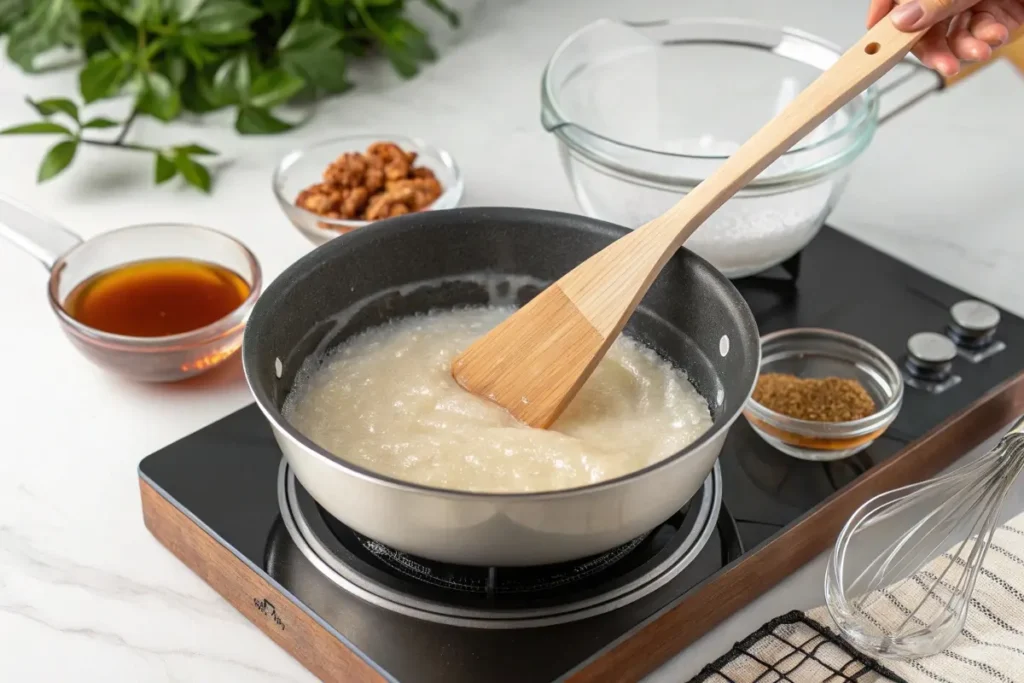
In these techniques, every detail matters—from the precise ratio of starch to water, to the gentleness of stirring. By mastering these steps, you’ll be well on your way to creating Japanese warabi recipes that replicate the authentic taste of this classic dessert.
Internal link: For more inspiration on Japanese sweets, explore our Japanese Dessert Recipes, where tradition meets creativity.
Warabimochi vs. Mochi: Key Differences
Warabimochi and mochi are both beloved Japanese confections, yet they diverge significantly in terms of ingredients, texture, and cultural context. Understanding these differences enriches your appreciation for each dessert and can guide you in selecting the perfect sweet treat based on your preferences.
Ingredient Distinctions
- Glutinous Rice Flour vs. Bracken Starch
Classic mochi is made by steaming and pounding glutinous rice or by using shiratamako (refined rice flour). Warabimochi, on the other hand, relies on starch from bracken roots (warabi). This fundamental difference influences both flavor and texture. - Availability
Glutinous rice flour is relatively easier to source worldwide, while bracken starch can be rare and more costly. Authentic warabi mochi recipe variations often blend cheaper starches to reduce the expense without sacrificing too much of the original texture.
Textural and Taste Variations
- Chewy vs. Silky
Traditional mochi is famed for its chewy, elastic quality that can be quite dense. Warabimochi is softer, almost jelly-like, and dissolves more readily in your mouth. - Sweetness Level
Mochi dough itself typically has a subtle flavor, becoming sweet or savory depending on the filling (such as sweet bean paste or ice cream). Warabimochi usually has a milder taste, enhanced through kinako or kuromitsu.
Cultural Significance
- Usage in Festivals
Mochi is deeply ingrained in Japanese celebrations like the New Year (Oshogatsu) and is central to many rituals. Warabimochi is commonly enjoyed in summer, prized for its refreshing qualities. - Regional Preferences
Mochi boasts numerous regional variants across Japan—from the pink and white hanami dango to savory grilled isobe maki—while warabimochi is especially popular in the Kansai region, particularly Kyoto and Osaka.
Why is Warabimochi Often More Expensive?
- Rarity of Bracken Starch: Authentic warabimochi requires high-quality bracken starch, which is labor-intensive to produce and less readily available.
- Small-Scale Artisanal Production: Specialized confectioners often make warabimochi in limited batches, elevating its price due to craftsmanship and exclusivity.
- Seasonal Demand: Its popularity peaks in summer, leading to occasional scarcity that can drive up costs.
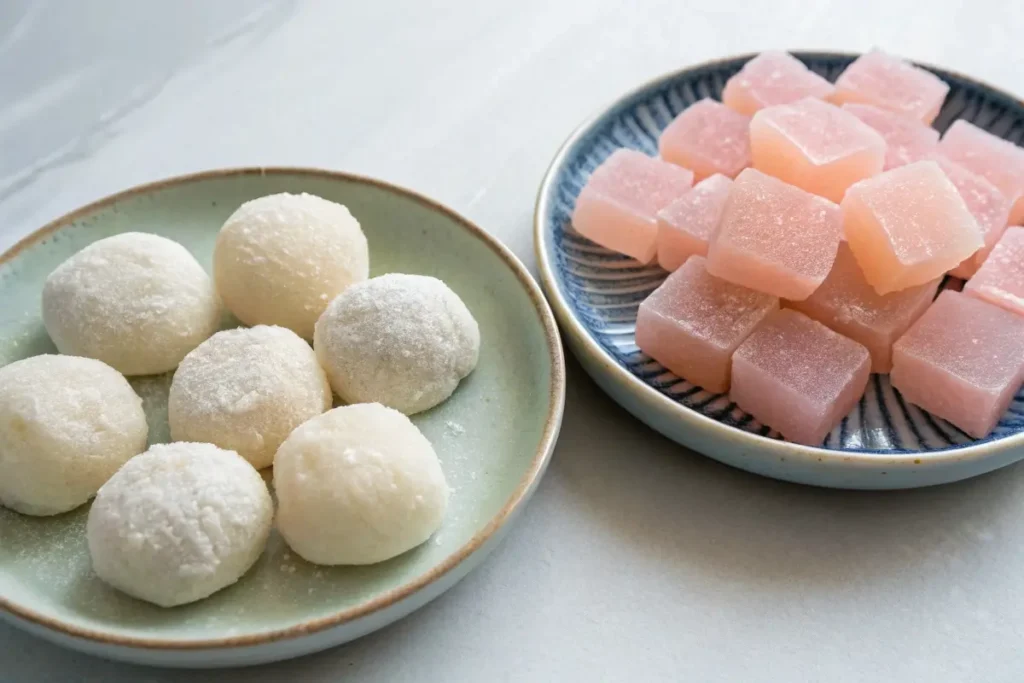
In essence, mochi and warabimochi share a heritage of delighting sweet-toothed enthusiasts but stand apart in ingredient origin, mouthfeel, and cultural connotations. Knowing these nuances can help you select exactly which dessert suits your cravings or the occasion you’re celebrating.
Internal link: Uncover more about Japanese plant-based sweets on our Japanese Vegan Recipes, featuring creative twists on time-honored favorites.
Warabimochi in Modern Cuisine:
As global culinary trends embrace cultural fusion, warabimochi has evolved beyond the realm of traditional tea parlors and local sweet shops. Chefs worldwide, as well as home cooks, have discovered fresh ways to incorporate warabimochi into modern dishes, demonstrating its adaptability and timeless allure.
Fusion Desserts and Beverages
- Warabimochi Parfait
Urban cafes in Tokyo and beyond have introduced layered parfaits featuring warabimochi, fresh fruits, whipped cream, matcha ice cream, and crunchy toppings like granola. This contemporary version fuses Japanese dessert craftsmanship with Western presentation. - Bubble Tea Twist
Some bubble tea shops experiment by adding small warabimochi cubes instead of (or alongside) tapioca pearls. This fusion approach offers a lighter chewiness and a delicate flavor that pairs well with milk teas or fruit-based teas.
Savory Pairings
Surprisingly, warabimochi can also appear in savory contexts:
- Warabimochi Salad
In some innovative restaurants, chefs sprinkle slightly salted warabimochi cubes over fresh greens, pairing them with sesame dressings or citrus-based vinaigrettes. The result is a salad that contrasts crisp vegetables with soft, bracken-based morsels. - Appetizer Variations
Warabimochi is occasionally served with soy sauce or miso-based dips, introducing a savory spin. This approach highlights the dessert’s neutrality, proving its capacity to blend into flavors beyond the sweet realm.
Artisanal and Specialty Shops
Exclusive shops dedicate themselves to warabimochi artistry, crafting variations that incorporate premium matcha, unique sugars, or fruit infusions. These confections often come in elegant packaging, making them popular gifts or souvenirs. In Japan’s bustling urban centers, lines can form outside specialty shops that produce warabimochi in limited daily batches.
Social Media Buzz
Thanks to social media platforms, pictures of translucent warabimochi dusted in golden kinako or drizzled with dark syrup have gone viral. Food bloggers and influencers highlight the dessert’s aesthetic appeal, further boosting global interest.
By melding tradition with innovation, warabimochi remains relevant in a rapidly evolving culinary landscape. From haute cuisine interpretations to everyday boba shops, this adaptable dessert continuously captivates new audiences and inspires creative recipes that pay homage to its delicate yet satisfying character.
External link (high-authority resource): For additional reading on bracken starch and its uses, you can refer to the Wikipedia entry on Bracken for an overview of how the plant is cultivated and processed.
Crafting the Ultimate Warabimochi at Home
Making authentic warabimochi recipe at home is simpler than it might seem, especially if you have the right ingredients and a little patience. Here’s a quick guide to help you recreate this traditional dessert in your own kitchen.
Essential Tools and Ingredients
- Bracken Starch (Warabi Ko): Aim for a high-quality starch. If pure bracken starch is inaccessible, use a blend of tapioca and potato starch for a comparable texture.
- Mixing Utensils: A wooden spatula and a sturdy saucepan are ideal. The wooden spatula helps maintain an even stir without damaging your pan.
- Kinako and Kuromitsu: These staples are crucial for finishing touches. Kinako adds a nutty dimension, while kuromitsu offers a deep sweetness.
Step-by-Step Quick Reference
- Measure and Mix: Blend the starch and water in a 1:6 or 1:7 ratio, depending on how firm you want your warabimochi.
- Heat and Stir: Place on medium heat, stirring continuously. The mixture will slowly turn translucent.
- Cool Down: Pour onto a tray or into a bowl and let it cool. You can place the dish in the refrigerator for quicker setting.
- Shape and Serve: Cut into cubes or spoon into portions. Generously dust with kinako and drizzle with kuromitsu.
Serving Suggestions
- Chilled Delicacy: Warabimochi is best enjoyed cool or at room temperature, especially in warmer weather.
- Matcha Pairing: Serve alongside a bowl of matcha tea to contrast the slight bitterness of matcha with the mild sweetness of warabimochi.
- Modern Twists: Experiment with sprinkling toasted sesame seeds or shaved coconut for added texture.
With minimal equipment and a handful of ingredients, you can bring the delightful taste of warabimochi into your home. It’s a straightforward process that rewards you with a refreshing sweet treat, bridging the gap between age-old tradition and modern homemade convenience.
History of Warabimochi: Origins and Evolution
Warabimochi’s roots trace back centuries in Japan, though exact historical records can be somewhat elusive. Initially, the use of bracken starch for culinary purposes was tied to practical resourcefulness and the abundance of warabi ferns in certain regions. Over time, cooks realized that bracken starch created a uniquely soft, translucent sweet when combined with water and gently heated.
Ancient Beginnings
- Rural Communities: In earlier periods, rural communities in mountainous areas often relied on bracken plants as a supplemental food source. Extracting starch from the bracken root demanded painstaking effort, making the end product particularly cherished.
- Seasonal Importance: Warabimochi emerged as a popular summertime treat, providing a cooling relief during hot and humid months. Its delicate mouthfeel and lightness contrasted heavier rice-based sweets typically consumed in colder seasons.
Development Through the Ages
- Popularity in the Edo Period: As Japan’s economy and cultural practices flourished during the Edo period (1603–1867), sweet shops in Kyoto and Osaka experimented with novel confections. Warabimochi found a place in teahouses serving wagashi, the collective term for Japanese sweets enjoyed alongside tea ceremonies.
- Rise of Specialty Shops: By the 19th century, specialty shops dedicated to warabimochi began appearing, especially in Kansai. Craftsmen perfected techniques to produce translucent textures, unveiling new flavor pairings with kinako, sweet bean pastes, and sugar syrups.
Modern-Day Recognition
- Regional Variations: Different prefectures in Japan introduced their own spin on warabimochi, some focusing on a firmer consistency while others preferred a near-silky texture.
- Popularity with Tourists: With the rise of culinary tourism, warabimochi quickly became a staple among visitors eager to taste authentic Japanese sweets. Street vendors and high-end patisseries alike showcased warabimochi to cater to diverse palates.
- Global Spread: As the world discovered the nuances of Japanese desserts beyond sushi and ramen, warabimochi gained international attention. Its airy sweetness and gluten-free nature appealed to a growing base of health-conscious dessert lovers.
The dessert’s enduring legacy is a testament to Japan’s deep culinary heritage and constant innovation. From humble origins in rural mountain villages to its current status as a sought-after delicacy, warabimochi remains a symbol of refined simplicity—capturing the essence of nature, tradition, and seasonal indulgence.
Internal link: For an expanded look at other cultural desserts in Japan, you can Discover Japanese Recipes that similarly draw on regional ingredients and techniques.
Practical Examples & Use Cases: Enjoying Warabimochi Beyond Dessert
Warabimochi’s versatility goes beyond a standalone sweet treat. With a bit of creativity, you can introduce warabimochi into a variety of dining experiences, from special occasions to everyday meals.
Afternoon Tea Delights
If you’re hosting an afternoon tea gathering, warabimochi can serve as a refreshing palate cleanser between savory and sweet courses. Arrange small cubes on a decorative platter, offering kinako and powdered matcha on the side for guests to customize their experience.
Seasonal Festivities
During hanami (cherry blossom viewing) or summer festivals, warabimochi is a popular street snack. It can be skewered, lightly dusted with kinako, and offered as a grab-and-go treat, complementing the festive atmosphere and seasonal traditions.
Health-Conscious Substitutions
Thanks to its relatively low calorie content and naturally gluten-free bracken starch, warabimochi can be a sensible alternative to heavier cakes or pastries. For example, you might:
- Replace Heavier Desserts: Serve chilled warabimochi at picnics or barbecues to offer a light, sweet option.
- Incorporate in Fruit Bowls: Combine fresh fruit chunks, yogurt, and warabimochi cubes for a nutritious breakfast bowl or post-dinner delight.

Whether it’s part of a sophisticated tea ceremony or simply a chilled snack on a sunny day, warabimochi thrives in diverse scenarios. By experimenting with presentations—like pairing it with fruit, integrating it into layered desserts, or even exploring savory fusions—you’ll discover the endless potential of this translucent, subtly sweet delight.
FAQs
Below are answers to some of the most common questions people have about warabimochi. These FAQs aim to demystify this traditional sweet and guide you in appreciating its nuances.
1. What is warabimochi made of?
Authentic warabimochi is primarily made of bracken starch, sourced from the roots of the bracken fern. This gives the dessert its unique translucency and soft texture. Some modern versions use alternative starches—like tapioca or potato—to imitate the consistency if pure bracken starch isn’t readily available.
2. What does warabimochi taste like?
Warabimochi has a mild flavor with a subtle, earthy undertone from the bracken starch. It’s often sweetened and enhanced by kinako (roasted soybean flour) or kuromitsu (black sugar syrup), which add depth and sweetness. The dessert itself has a cooling, almost melt-in-your-mouth feel.
3. What’s the difference between mochi and warabimochi?
While mochi typically uses glutinous rice flour, warabimochi is made from starch extracted from bracken ferns. Mochi is chewy and dense, whereas warabimochi is silkier and more jelly-like. They also differ in cultural contexts—mochi is often associated with New Year festivities, while warabimochi is a common summertime treat.
4. Why is warabi mochi so expensive?
The cost often reflects the rarity and quality of bracken starch. Authentic bracken starch can be labor-intensive to produce, and artisans may only produce it in limited quantities. Premium versions that stick to 100% warabi starch can command higher prices compared to desserts made with mixed or alternative starches.
5. Can warabimochi be vegan or gluten-free?
Yes, most traditional recipes are already vegan and gluten-free, using only starch, water, and sugar. However, it’s wise to double-check labels on store-bought varieties, especially for any added flavors or sweeteners.
These frequently asked questions highlight the essence of warabimochi—from its ingredients to its premium pricing. Knowing these details will help you better enjoy and even create your own warabimochi experience, whether you stick to tradition or experiment with modern twists.
Conclusion:
Warabimochi exemplifies the delicate artistry of Japanese desserts, weaving together centuries of culinary heritage with a refreshing twist perfect for hot summer days or whenever you crave something light. Its translucent texture, derived from bracken starch, imparts a softness that contrasts beautifully with the bold sweetness of kinako or kuromitsu. This balance of flavors and mouthfeel is precisely what has kept warabimochi relevant, even as the world of sweets grows ever more diverse.
Whether you prefer a chilled cube of warabimochi dusted in roasted soybean flour or an innovative parfait layered with fruit and whipped cream, the dessert’s adaptability shines. It can take center stage at a formal tea ceremony or serve as a casual treat you enjoy at a local festival stand. The key lies in appreciating the craft behind each batch—the careful extraction of starch, the mindful stirring, and the devotion to subtlety and harmony that define Japanese confectionery.
Explore more delightful Japanese confections to continue your journey through Japan’s sweet traditions. With warabimochi as your guide, you’ll uncover a dessert culture that honors simplicity, precision, and a true reverence for nature’s bounty.
